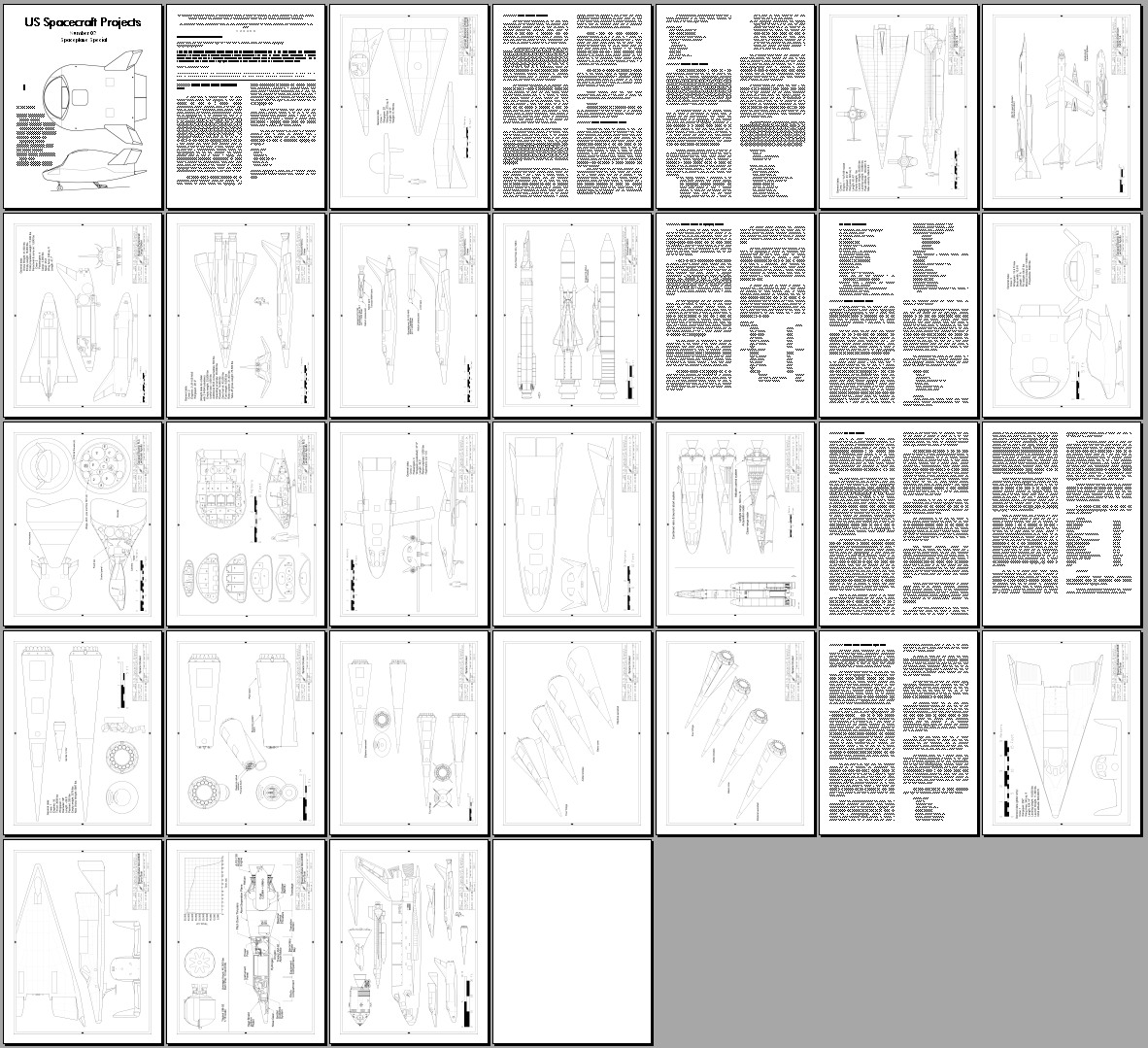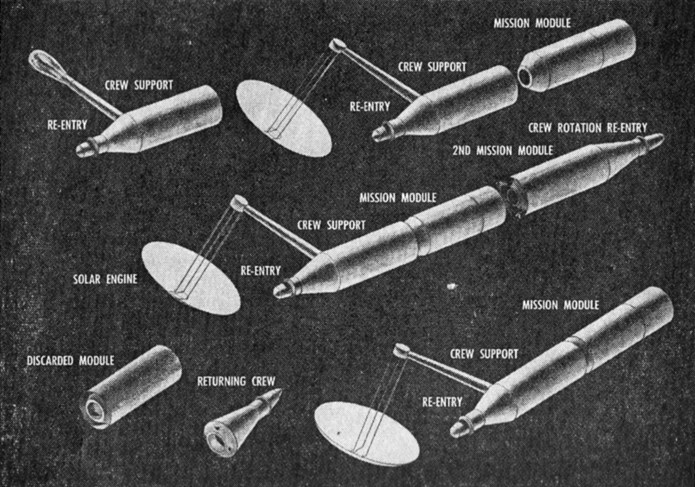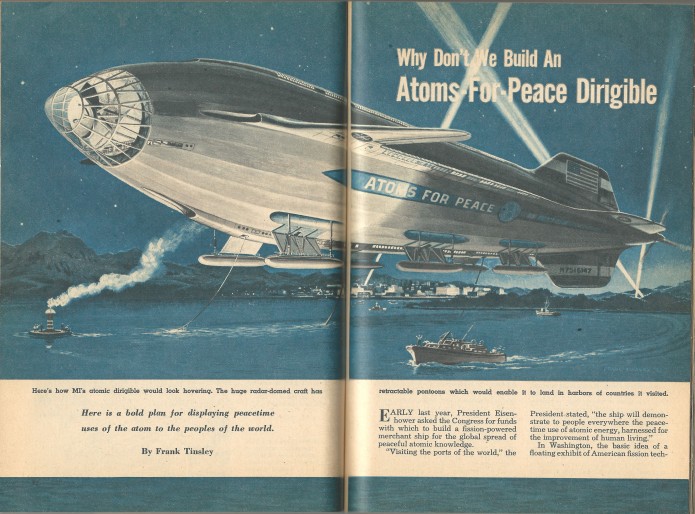DARPA has released a shiny new video of the ALASA (Airborne Launch Assist Space Access) concept. The video seems to show a different design than that described HERE, which describes the vehicle as using the same engines for both the first and second stages (thus why there are four “tractor” rockets). The vehicle would ditch the first stage propellant tanks and use the same engines for stage 2. But the video shows the first stage dropping off and takign the engines with it. This would seem to negate the value of using tractor rockets. Also, the propellant is said to be a mix of nitrous oxide and acetylene, mixed together and chilled, in a single tank. This would make the design simple. But it seems a little spooky to me; acetylene has the unfortunate habit of detonating on its own unless stabilized; perhaps nitrous oxide does that. Propellants made from mixes of liquid oxidizers and liquid fuels have been made to work before, but there are definite safety concerns.
In general, I can complete a diagram for the US Aerospace Projects series in anywhere from a handful of hours to a couple man-days, depending on detail and how much 3D work I need to do (the Space Cruiser from US Spacecraft Projects #2 was a chore because a lot of time was spent on 3D modeling). But even at the long end of the bell curve, this would seem to indicate that I should be able to finish a full set of 8 vehicle diagrams in a week or less. But it hasn’t worked out that way; it’s usually quite a bit longer. Why? Because the diagramming is pretty much the *last* stage in the process.
In order to come up with 8 diagrams, I have to decide on 8 vehicles. Sometimes that’s easy, like when I have a known design series that I’m working on (the B-52 & B-59 series in USBP, for example). Sometimes I get obsessed that I have to do some particular design… the Space Cruiser was one such. And then the next step after deciding on which vehicle is collecting the info needed on each one.
In many cases, I have all the info I need. I have a number of Space Cruiser documents I’ve collected over the years, enough to do the project justice. But just because I have a document doesn’t necessarily mean I *remember* that I have the document… or when I do remember it, remember where I put it. I spend quite a while digging for a document on SC that I only halfway vaguely remembered that I had.
And then when I find the documents, there’s the going through them, looking for the relevant and useful bits. Sometimes that’s easy: the whole thing is described in a single AIAA paper that has four pages and one diagram. Limited data means a limited diagram and description on my part. But sometimes the design is buried in *vast* reports, or scattered across a number of presentations. And while there might be thousands of pages, there are only a few pages that are directly valuable. Such as a design I’m digging up now for US Launch Vehicle Projects #1, for which the research stack is the entire box you see here:
FYI: the cardboard box under the plastic box contains a series of GD SSTO reports for future use; the half-filled box behind is a small fraction of my wholly uncatalogued Saturn/Apollo collection.
So if you see me flacking a US “X” P publication and think that I’m just slapping these things together… ah… no. Simple though they may look, they are each the result of a *lot* of work, often based on reports that I gathered ten, fifteen years ago hoping to *someday* find some use for.
————-
Please consider signing up to become a patron. For a pittance per month, you get all kinds of aerospace history goodies.
Last night I went to upload the monthly catalogs of diagrams & documents for the $10-level Patreon patrons to choose from… and found that something screwy is going on with the file attachment system. After much useless flailing I determined that the system, which has worked fine until now, is just plain broken. However, an alternate system seems to have presented itself which should work just fine. And additionally I wound up adding two pieces of high-rez artwork for $4-and-up-level patrons… an X-14C VTOL ground attack plan weapons loadout display, and the Bell “Mighty Mouse” small assault transport tiltrotor. If you would like to become a patron and get occasional bonus goodies like these (as well as the regular monthly rewards), please consider signing up to become a patron. For a pittance per month, you get all kinds of aerospace history goodies.
The full-size versions (available to $4 patrons under the “Creations” tab) are much bigger:
A Ryan concept for recovery of the Saturn I first stage. Somewhere around here I have a report on using such a system to recover a Saturn I used to launch a Dyna Soar…
The idea was that the stage could glide back to a runway landing in Florida. As memory serves, in order to pull that off some propulsive capability was needed, such as restarting the engines and doing a retro-burn while still above the sensible atmosphere. The stage would return unmanned.
I’ve started posting my diagrams created for APR, USBP, etc. over on “Deviantart.” Unless I get bored and wander away (gosh, what are the chances of *that*), the plan is to eventually post virtually *all* of my diagrams, at a rate of about one a day.
Check it out:
scott-lowther.deviantart.com
Feel free to tell anyone you care to tell.
Coming soon to a sky near you, hopefully:
Now available: US Spacecraft Projects #02, the “Spaceplane Special.” This is done in the same style as the other US Aerospace Projects publications, but this issue is focused specifically on lifting spacecraft… and is more than twice as long as usual with more data and more diagrams.
USSP #02 includes:
- Boeing Personnel/Cargo Glider: When you have space industry, you need a space bus
- Convair Manned Orbiting Reconnaissance System: A 1958 concept for a recon spaceplane
- North American D435-1-4: The delta winged X-15A-3 (not a true spaceplane… but still, relevant)
- General Electric R-3 Lenticular Apollo: A 1962 Apollo concept for a lifting body lunar ship
- General Dynamics VL-3A: a 1966 space station logistics transport
- SRI Space Cruiser: An early 1980’s minimum manned spacecraft for the military
- Boeing Model 844-2050E Dyna Soar: The almost-built spaceplane from 1963
- Rockwell MRCC Orbiter: the do-everything concept, modified with additional rockets and propellant
USSP #02 can be downloaded as a PDF file for only $6:
———
Illustrations of a Martin concept from 1961 called “DEIMOS” (Development and Investigation of a Military Orbital System). Pitched to the Air Force, this entailed a modified Titan II launch vehicle, a standard cargo hauler and a scaled-up two-man Mercury capsule (this was before Gemini was finalized). The result was something akin to a smaller version of the later MOL (Manned Orbiting Laboratory). The Titan II described here (modifications unknown) could put a 10,000 pound payload into a 300 nautical mile orbit.
Capabilities and roles of DEIMOS were not provided, but it would presumably serve much the same role as MOL, though simpler and lighter weight: basic science as well as reconnaissance and intelligence gathering. The claim as of August 1961 was that if work began soon DEIMOS could begin flying in 1963.
I’ve made available to all APR Patreon patrons full-rez scan of of an article from Mechanix Illustrated, March, 1956. “Why Don’t We Build an Atoms-For-Peace Dirigible” was written and illustrated by Frank Tinsley and is, to say the least, kinda technologically optimistic. But it demonstrated a difference in psychology between then and now… sixty years ago, thinking this kind of big was not seen as crazy as it would be today.
If this is of interest, please consider signing up to become a patron. For a pittance per month, you get all kinds of aerospace history goodies.








